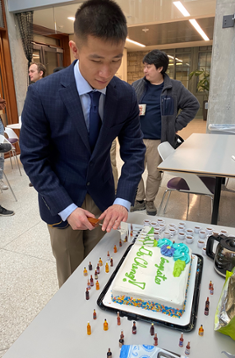Matthew Cheng defends dissertation
Matthew Cheng defended his thesis, "Defects and Interfaces in Quantum Systems: van der Waals Crystals and Superconducting Transmons" on March 16th, 2023. Below is a summary of his dissertation.
PhD Abstract: Motivated by further miniaturization of conventional electronics, where dimensions approaching the atomic scale leads to properties that are increasingly dominated by quantum processes, a variety of research fields in quantum materials such as two-dimensional materials and superconducting quantum bits (qubits) have been established. However, it is of the utmost import to study the underlying structure-property paradigm that governs the exhibited properties in these quantum systems. This dissertation discusses how the incorporation of multiple analysis techniques, with an emphasis on electron microscopy at the nanoscale, can be used to study the structural and chemical ordering within van der Waals layered materials and within the interfaces of superconducting thin films to develop design principles for the fabrication of next generation quantum materials. In the first area of study, a systematic top-down analysis scheme at multiple length scales of new bimetallic Co-containing 2D thiophosphates is undertaken. The first two studies focused on the synthesis and bulk structural characterization of both Fe2-xCoxP2S6 and MnxCo2-xP2S6 as well as their magnetic properties as the alloying ratio of the metal cations are varied. In the second area of study, analytical electron microscopy at the nanoscale is leveraged to study different interfaces of superconducting quantum materials such as the metal-substrate and the metal air-interface to guide the development and processing conditions to optimize and improve the decoherence times of transmon qubits. In the first study, the metal-substrate interface of the Josephson Junction (JJ) region of an array of transmon qubits provided by Rigetti Computing is analyzed with (scanning) transmission electron microscopy ((S)TEM) and the interfacial properties are correlated with the measured coherence times. It is found that the interface with the lowest coherence time incorporated the highest oxygen content. This is accompanied with a second study on the utilization of a capping layer on a Nb thin film to study the potential of using TiN or Pt/TiN to inhibit the growth of Nb2O5 usually formed in the Nb superconducting thin films during the synthesis and processing procedures, which are reportedly considered as one of the major sources of decoherence in superconducting qubits.


